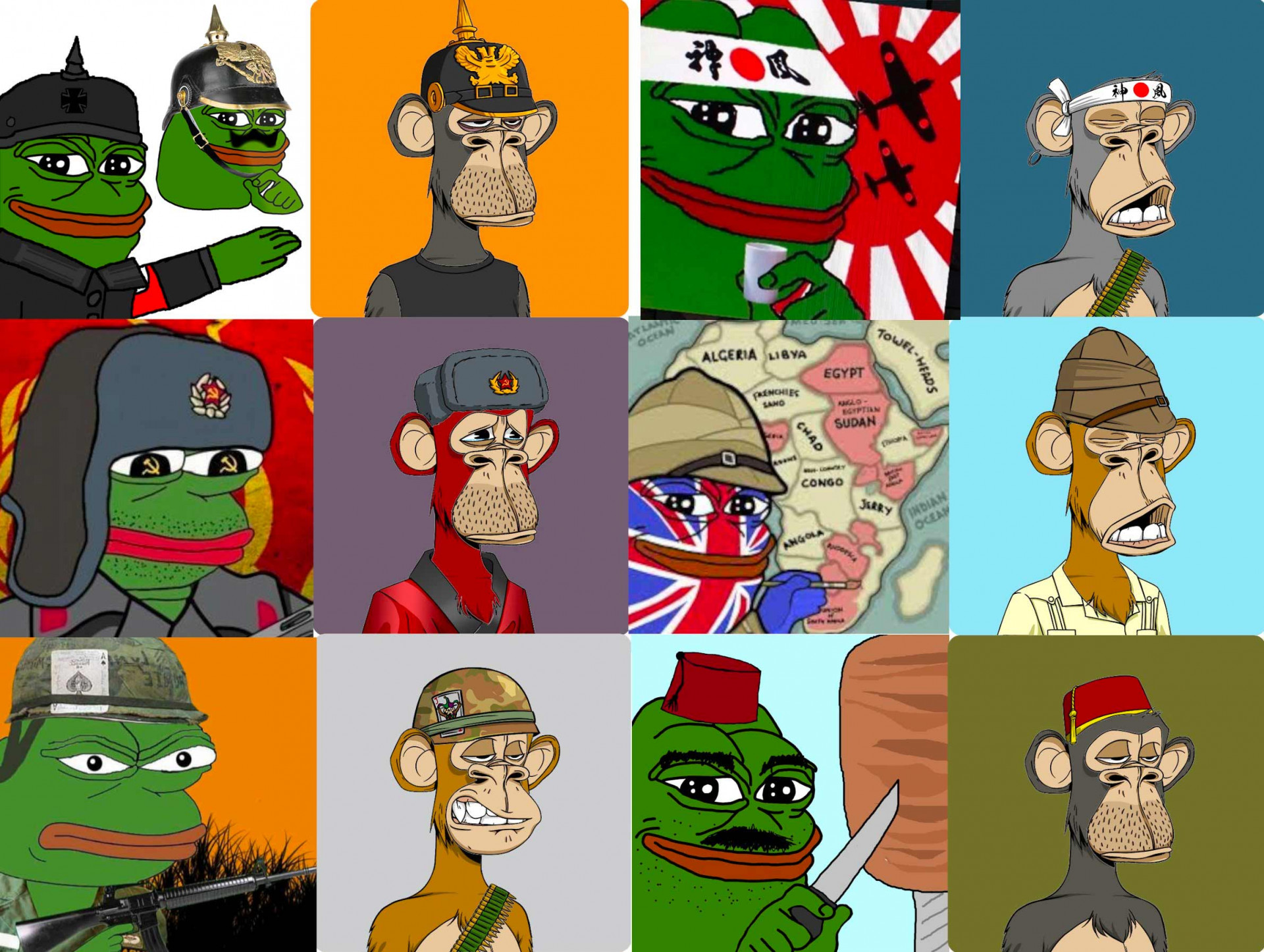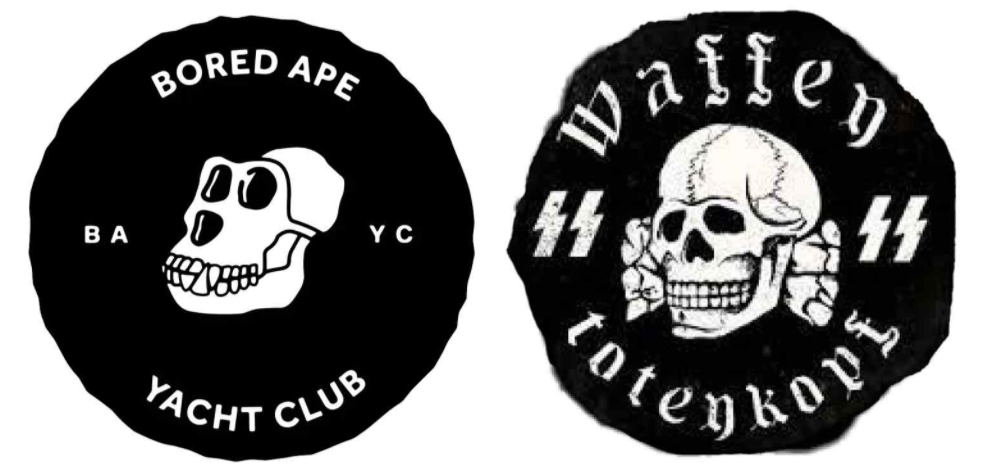Almost Normal
The latest edition of Art Dubai Digital looks more like a regular art fair than its predecessors, but still has subversive and experimental work.


Could the speed of the NFT market—which often comes at the expense of reflection on artistic intent and sociopolitical context—allow fascist aesthetics to circulate unencumbered in a time when far-right extremism is on the rise globally? The creators of Bored Ape Yacht Club (BAYC) have been accused with propagating racist imagery and neo-Nazi references by artist Ryder Ripps and others. Yet this has barely impacted the high value of the NFT series. There is a long history of mainstreaming fascism through art, memes, and merchandise, from Italian Futurism to Pepe the Frog and Proud Boy-associated apparel. The innocuous presentation of the BAYC brand means that any connections to neo-Nazi imagery can be dismissed as conspiratorial speculation. But no matter what the intent of the creators may be, the success of BAYC raises the question of why pop culture is still profiting from racist symbols, and offers an entry point for identifying how alt-right extremists are making gains in the NFT field.

BAYC is a collection of ten thousand ape portraits that has surpassed 1 billion USD in sales on OpenSea. Celebrity collectors of the NFTs include Snoop Dogg, Paris Hilton, Chris Rock, and Jimmy Fallon. Why apes? “Apeing” is crypto slang for buying a token without due diligence because of FOMO on potential gains. Yuga Labs, the creators of BAYC, says this term inspired the project. Before being adopted into the crypto lexicon, however, the simianization trope was used to dehumanize Black people by comparing them to monkeys. NFTs that assign dollar value to digital trading cards where apes wearing grills and gold chains are categorized as “hip hop,” and another wears a “sushi chef headband,” are examples of racial capitalism, a practice that degrades people of color by commodifying racial identity.
Fascist art disentangles symbols from hate and connects them with pleasure, justifying malevolence as apolitical.
In January, Ripps published a Twitter thread addressing coded symbols in the NFT collection, sparking responses that ranged from vehement denial to commiseration over an issue that had troubled people for a long time. (He later compiled his research on the site gordongoner.com.) Ripps identified a striking resemblance between the BAYC logo and the Nazi Totenkopf emblem. Both skulls have eighteen teeth, a cryptogram used by white supremacists to reference Adolf Hitler (1=A, 8=H). He also linked the name of Yuga Labs to Kali Yuga, an alt-right meme that represents a dark age marked by perversion and destined for destruction; it was once touted by fascist activist Savitri Devi, who saw Hitler as an Aryan prophet who would lead the world back to moral purity. BAYC was publicly announced on April 21, 2021, but in an interview the co-creators marked the “official launch” as April 30, the date of Hitler’s death. Despite Ripps’s findings, the creators of BAYC maintain any racist subtext is coincidental. It’s worth noting that a recent article quotes Mark Pitcavage, a senior research fellow at the Anti-Defamation League, who finds the research connecting BAYC to neo-Nazism insubstantial. Pitcavage and his colleague, Carla Hill, still offered criticism of the collection’s racial stereotyping. Even so, Ripps suggests, “[it] is a terrible example to other creators, setting a bad tone for future generations of art—we have already seen it morph into increasingly racist offshoots.”

Fascist art disentangles symbols from hate and connects them with pleasure, justifying malevolence as apolitical. Brands have profited from commercializing far-right extremism. Thor Steinar, the favorite clothing label of German neo-Nazis, sells apparel covered in Germanic runes and Viking symbols. Stateside, alt-right brands advertise online with divisive slogans like “Death to Liberals” or “MAGA Civil War.” Andrew Anglin, editor of the neo-Nazi website The Daily Stormer, has raised at least $5 million through cryptocurrency. And now, overtly racist, xenophobic, and anti-Semitic NFT brands can reap economic gain and create fervent fanbases through the rapid circulation and decentralized nature of web3.
Anyone operating in the NFT space has a responsibility to question intent and create context for the most financially valuable and popular projects on the market.
Last November, alt-right cartoonist Stonetoss minted Flurks, a series of cartoons flashing the “OK” symbol—an IYKYK gesture used of internet neo-Nazis—and accessorized with MAGA hats and Confederate flags. After selling out in 22 minutes for almost 2 million USD, the collection was delisted on OpenSea and Rarible, and a marketing opportunity emerged. Popular crypto Youtube personality Ben Armstrong criticized the censorship, and Stonetoss identified a market ready to joke about George Floyd, rape, and trans lives.
Anyone operating in the NFT space has a responsibility to question intent and create context for the most financially valuable and popular projects on the market. The NFT boom offers an opportunity to upset traditional hierarchies and strike it rich. Fascism has succeeded in the past by making similarly democratic promises, except the collective buy-in directly supported the usurpation of power by a dominant few. Even if BAYC’s NFTs aren’t directly inciting violence, they don’t exist in a vacuum. Intentional or not, BAYC’s use of simianization and other coded symbols used by the alt-right taps into a culture of prejudice. The blockchain offers exciting potential for creative practices, but it’s imperative we question the value systems that gain power and visibility in the field.
Mad Pinney is a writer, as well as the programs manager at POWRPLNT, and community manager at Artwrld.
